
Minute Man National Historical Park commemorates the opening battle in the American Revolutionary War. It also includes the Wayside, home in turn to three noted American authors. The National Historical Park is under the jurisdiction of the National Park Service and protects 970 acres (392.5 ha) in and around the Massachusetts towns of Lexington, Lincoln, and Concord.

Buckman Tavern is a historic American Revolutionary War site associated with the revolution's very first battle, the 1775 Battle of Lexington and Concord. It is located on the Battle Green in Lexington, Massachusetts and operated as a museum by the Lexington Historical Society.
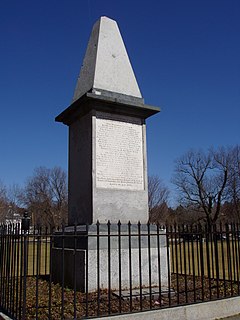
The Lexington Battle Green, also known as Lexington Common, is the historic town common of Lexington, Massachusetts, United States. It was at this site that the opening shots of the Battles of Lexington and Concord were fired on April 19, 1775, starting the American Revolutionary War. Now a public park, the common is a National Historic Landmark.

The Concord Monument Square–Lexington Road Historic District is an historic district in Concord, Massachusetts. Monument Square, at the center of the district, was laid out in 1635. The district includes a collection of well-preserved residential houses stretching along Lexington Street southeast from the square, and along Lowell northwest of the square. The square is prominently known as the site of British activities on April 19, 1775, the day of the Battles of Lexington and Concord which began the American Revolutionary War, and of earlier meetings by Massachusetts Patriots which were held in the First Parish Church and Wright's Tavern. The Tavern and the Ralph Waldo Emerson House, which stands near the eastern end of the district, are both National Historic Landmarks. The district was listed on the National Register of Historic Places in 1977.

The Col. James Barrett Farm is a historic American Revolutionary War site in Concord, Massachusetts, associated with the revolution's first battle, the 1775 battles of Lexington and Concord. His farm was the storage site of all the town of Concord's militia gunpowder, weapons and two pairs of prized bronze cannons.
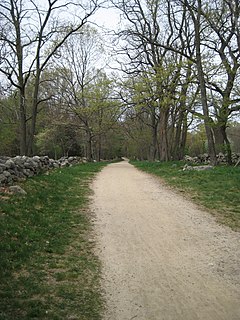
Battle Road, formerly known as the Old Concord Road and the Bay Road, is a historic road in Massachusetts, United States. It was formerly part of the main road connecting Lexington, Lincoln and Concord, three of the main towns involved in the American Revolutionary War. It was on Battle Road that thousands of colonial militia and British regulars fought during the redcoats' retreat from Concord to Boston on the morning and afternoon of April 19, 1775.
The towns of Concord and Lexington, Massachusetts are the site of Minute Man National Historical Park, a park governed by the National Park Service. The most highly-attended event in the park is the annual reenactment of the first shots of the Battles of Lexington and Concord, performed by the Lexington Minute Men Company and His Majesty's Tenth Regiment of Foot.

Hartwell Tavern is a historic American Revolutionary War site associated with the revolution's first battle, the 1775 battles of Lexington and Concord. It is located on North County Road, just off Battle Road in Lincoln, Massachusetts, and operated as a historic house museum by the National Park Service as part of the Minute Man National Historical Park. Built in 1733, in what was then Concord, it is staffed from Memorial Day (May) weekend to October by park rangers dressed in colonial attire who offer programs daily.
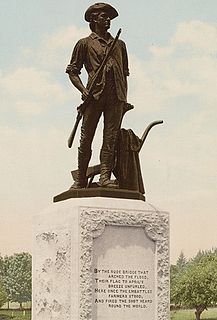
The Minute Man is an 1874 sculpture by Daniel Chester French in Minute Man National Historical Park, Concord, Massachusetts. It was created between 1871 and 1874 after extensive research, and was originally intended to be made of stone. The medium was switched to bronze and it was cast from ten Civil War-era cannons appropriated by Congress.
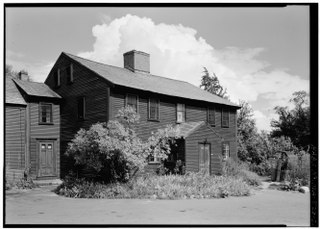
The Samuel Hartwell House is a historic American Revolutionary War site associated with the revolution's first battle, the 1775 battles of Lexington and Concord. Built in 1733, in what was then Concord, it was located on North County Road, just off Battle Road in today's Lincoln, Massachusetts, and about 700 feet east of Hartwell Tavern, which Hartwell built for his son, Ephraim, and his newlywed wife, Elizabeth, in 1733. The site is part of today's Minute Man National Historic Park.

The Captain William Smith House is a historic American Revolutionary War site in Lincoln, Massachusetts, United States. Part of today's Minute Man National Historic Park, it is associated with the revolution's first battle, the 1775 battles of Lexington and Concord. Believed to have been built in 1692, in what was then Concord, it is believed to be the oldest house in Lincoln.

The Job Brooks House is a historic American Revolutionary War site in Lincoln, Massachusetts, United States. It is part of today's Minute Man National Historic Park.

The Jacob Whittemore House is a historic American Revolutionary War site in Lexington, Massachusetts, United States. It is part of today's Minute Man National Historic Park. It is located on Airport Road, just off Battle Road. It is the only house of the "witness" houses of the April 19, 1775 battles of Lexington and Concord to fall inside the Lexington town line; the others are in Lincoln or Concord.

The Samuel Brooks House is a historic American Revolutionary War site in Concord, Massachusetts, United States. It is part of today's Minute Man National Historic Park. It is located on North Great Road, just off Battle Road.

Virginia Road, also known as North County Road, North Country Road and Bay Road, is a historic road in Lincoln, Massachusetts, United States. It was part of Concord, Massachusetts, until 1754. Today, it is in the care of the Minute Man National Historical Park.
The Bloody Angle refers to a section of the Battle Road, in Lincoln, Massachusetts, on which two battles were fought on April 19, 1775, during the battles of Lexington and Concord in the first stage of the American Revolutionary War. The stretch of the mainly east–west-running road turns north for about 500 yards (460 m) and then east, as per the direction of travel during the British regulars' retreat from nearby Concord to Boston.

The Nathan Meriam House is a historic American Revolutionary War site associated with the revolution's first battle, the 1775 battles of Lexington and Concord. Built around 1705, it stands on Old Bedford Road, near its intersection with Lexington Road, in Concord, Massachusetts; the intersection is now known as Meriam's Corner. It is one of eleven houses within the Minute Man National Historic Park that still exists today. This area was part of the former Battle Road.
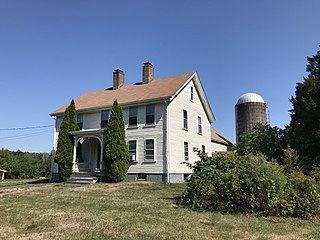
The Farwell Jones House is a historic American Revolutionary War site associated with the revolution's first battle, the 1775 battles of Lexington and Concord. Built in the early 18th century, it stands on Lexington Road in Concord, Massachusetts, just southwest of the former Battle Road. It is one of eleven houses within the Minute Man National Historic Park that still exists today.

The Stow-Hardy House is a historic American Revolutionary War site associated with the revolution's first battle, the 1775 battles of Lexington and Concord. It stands, on the site of a previous home built around 1689, on Lexington Road in Concord, Massachusetts, just southwest of the former Battle Road. It is one of eleven houses within the Minute Man National Historic Park that still exists today.
Brooks Hill is a location that featured in the battles of Lexington and Concord on April 19, 1775. It was here that the British regulars passed on their marches to Concord from Boston and again on their retreat east. It has also been referred to as Hardy's Hill.
















